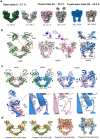A unified view on enzyme catalysis by cryo-EM study of a DNA topoisomerase
- PMID: 38418525
- PMCID: PMC10901890
- DOI: 10.1038/s42004-024-01129-y
A unified view on enzyme catalysis by cryo-EM study of a DNA topoisomerase
Abstract
The theories for substrate recognition in enzyme catalysis have evolved from lock-key to induced fit, then conformational selection, and conformational selection followed by induced fit. However, the prevalence and consensus of these theories require further examination. Here we use cryogenic electron microscopy and African swine fever virus type 2 topoisomerase (AsfvTop2) to demonstrate substrate binding theories in a joint and ordered manner: catalytic selection by the enzyme, conformational selection by the substrates, then induced fit. The apo-AsfvTop2 pre-exists in six conformers that comply with the two-gate mechanism directing DNA passage and release in the Top2 catalytic cycle. The structures of AsfvTop2-DNA-inhibitor complexes show that substantial induced-fit changes occur locally from the closed apo-conformer that however is too far-fetched for the open apo-conformer. Furthermore, the ATPase domain of AsfvTop2 in the MgAMP-PNP-bound crystal structures coexist in reduced and oxidized forms involving a disulfide bond, which can regulate the AsfvTop2 function.
© 2024. The Author(s).
Conflict of interest statement
The authors declare no competing interests.
Figures





Similar articles
-
Cryo-EM structures of African swine fever virus topoisomerase.mBio. 2023 Oct 31;14(5):e0122823. doi: 10.1128/mbio.01228-23. Epub 2023 Aug 23. mBio. 2023. PMID: 37610250 Free PMC article.
-
Human small cell lung cancer NYH cells selected for resistance to the bisdioxopiperazine topoisomerase II catalytic inhibitor ICRF-187 demonstrate a functional R162Q mutation in the Walker A consensus ATP binding domain of the alpha isoform.Cancer Res. 1999 Jul 15;59(14):3442-50. Cancer Res. 1999. PMID: 10416608
-
Structural insights into the gating of DNA passage by the topoisomerase II DNA-gate.Nat Commun. 2018 Aug 6;9(1):3085. doi: 10.1038/s41467-018-05406-y. Nat Commun. 2018. PMID: 30082834 Free PMC article.
-
Folding funnels and conformational transitions via hinge-bending motions.Cell Biochem Biophys. 1999;31(2):141-64. doi: 10.1007/BF02738169. Cell Biochem Biophys. 1999. PMID: 10593256 Review.
-
The mechanism of negative DNA supercoiling: a cascade of DNA-induced conformational changes prepares gyrase for strand passage.DNA Repair (Amst). 2014 Apr;16:23-34. doi: 10.1016/j.dnarep.2014.01.011. Epub 2014 Feb 22. DNA Repair (Amst). 2014. PMID: 24674625 Review.
Cited by
-
Structural basis for difunctional mechanism of m-AMSA against African swine fever virus pP1192R.Nucleic Acids Res. 2024 Oct 14;52(18):11301-11316. doi: 10.1093/nar/gkae703. Nucleic Acids Res. 2024. PMID: 39166497 Free PMC article.
-
Structural and functional insights into the T-even type bacteriophage topoisomerase II.Nat Commun. 2024 Oct 8;15(1):8719. doi: 10.1038/s41467-024-53037-3. Nat Commun. 2024. PMID: 39379365 Free PMC article.
-
Virtual Screening and Molecular Dynamics Simulation Targeting the ATP Domain of African Swine Fever Virus Type II DNA Topoisomerase.Viruses. 2025 May 7;17(5):681. doi: 10.3390/v17050681. Viruses. 2025. PMID: 40431693 Free PMC article.
References
-
- Fischer E. Einfluss der configuration auf die wirkung der enzyme. Ber. Dtsch. Chem. Ges. 1894;27:2985–1993. doi: 10.1002/cber.18940270364. - DOI
LinkOut - more resources
Full Text Sources
Miscellaneous

